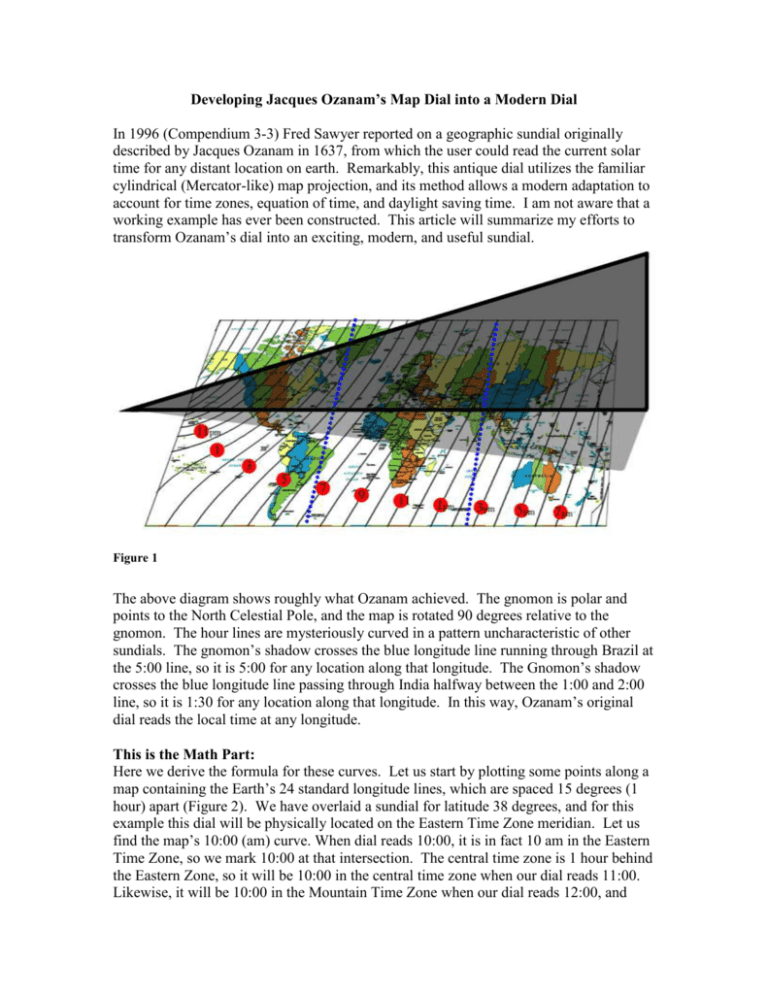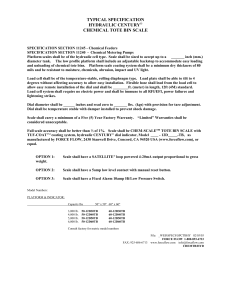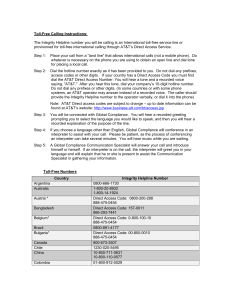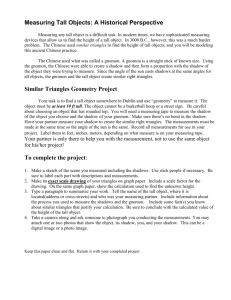Ozanam Map Dial article
advertisement

Developing Jacques Ozanam’s Map Dial into a Modern Dial In 1996 (Compendium 3-3) Fred Sawyer reported on a geographic sundial originally described by Jacques Ozanam in 1637, from which the user could read the current solar time for any distant location on earth. Remarkably, this antique dial utilizes the familiar cylindrical (Mercator-like) map projection, and its method allows a modern adaptation to account for time zones, equation of time, and daylight saving time. I am not aware that a working example has ever been constructed. This article will summarize my efforts to transform Ozanam’s dial into an exciting, modern, and useful sundial. Figure 1 The above diagram shows roughly what Ozanam achieved. The gnomon is polar and points to the North Celestial Pole, and the map is rotated 90 degrees relative to the gnomon. The hour lines are mysteriously curved in a pattern uncharacteristic of other sundials. The gnomon’s shadow crosses the blue longitude line running through Brazil at the 5:00 line, so it is 5:00 for any location along that longitude. The Gnomon’s shadow crosses the blue longitude line passing through India halfway between the 1:00 and 2:00 line, so it is 1:30 for any location along that longitude. In this way, Ozanam’s original dial reads the local time at any longitude. This is the Math Part: Here we derive the formula for these curves. Let us start by plotting some points along a map containing the Earth’s 24 standard longitude lines, which are spaced 15 degrees (1 hour) apart (Figure 2). We have overlaid a sundial for latitude 38 degrees, and for this example this dial will be physically located on the Eastern Time Zone meridian. Let us find the map’s 10:00 (am) curve. When dial reads 10:00, it is in fact 10 am in the Eastern Time Zone, so we mark 10:00 at that intersection. The central time zone is 1 hour behind the Eastern Zone, so it will be 10:00 in the central time zone when our dial reads 11:00. Likewise, it will be 10:00 in the Mountain Time Zone when our dial reads 12:00, and 10:00 in the Pacific Time Zone when our dial reads 1:00. Continuing along the other time zone meridians, we can lay out the map’s 10:00 curve. Proceeding in a similar manner, we then lay out the curves for all the other hours as well, eventually achieving a layout similar to Figure 1. Figure 2 Figure 3 expresses this mathematically, letting the distance between time zones on the xaxis be 1, and all angles expressed in degrees. Theta is the number of hours before or after solar noon, times 15 degrees/hour, and the formula y = x * Tan(Theta + 15x) * Sin(Lat) plots a single hour curve for a given Theta. Figure 3 Using Ozanam’s map to read Civil Time in any country: If you overlay Ozanam’s hour curves on top of a map which shows the time zone meridians, you will have a dial that indicates the time for each of those meridians. Shifting the map left-to-right under the Ozanam hour curves will advance or retard each meridian by the same number of minutes, which means this dial can be designed to be fully adjustable for the equation of time and for Daylight Saving Time. In the example to the right, the map shifts left to right under the hour curves and the gnomon’s shadow, which do not move. The upper frame shows the dial reading 7:00 in the European time zone (and 6:00 for GMT). The middle frame shows map shifted 10 minutes to the right for, say, an equation of time adjustment. The lower frame shows the map shifted 60 minutes to the right for Daylight Saving. Figure 5 shows an EoT graph drawn below the map, and a Standard Time and Daylight Saving indicator printed on the hour curve overlay. To properly adjust the dial, shift the map so that the correct date is indicated under the STD or DST line. Figure 5 Figure 4 I believe Ozanam oriented his map so that the gnomon would cross every longitude, and so for at least the mid-portion of each day, the dial would show the time anywhere in the world. But this creates a dial with a very large gnomon, and limits the duration of the day for which the shadow crosses all 24 time zones. What would happen if the gnomon arose near the center of the map? Figure 6. Hour numerals omitted for clarity. In figure 6, the gnomon arises from the Atlantic Ocean, and hour curves have been added for the south part of the dial (the west part of the map) by extending the calculation to include negative values of x. The pattern of the hour curves now shows its alluring symmetry. Unfortunately, this gnomon’s shadow will never cover all longitudes at once, and will never cover the eastern-most portion of the map. What is a dialist to do? Ozanam, meet Oglesby Figure 7 In 1999, Mac Oglesby described a shadowplane sundial that read the time using a movable string in place of a standard gnomon (Compendium 6-3). Applying his concept to Ozanam’s dial yields the dial in figure 7. A red mark identifies the spot where the gnomon’s style intersects the dial face, and a string is attached to a pole where the pole would intersect the upper style. The string is held taut in space, and as long as the shadow of the string falls on the red mark, the string will be in the shadow plane of the (now missing) gnomon, and the string’s shadow will read the proper time. In this manner, the string’s shadow can cover all time zones, and can do so for a greater portion of the day than Ozanam’s original map with the larger gnomon in figure 1. Note that the map can not read the time at the longitude of the red mark, because all hour lines converge at that point. For this reason I recommend designing the dial so that the red mark falls in a little used time zone, such as in the middle of the Atlantic Ocean. An astute observer will note that most hour lines appear three or four times on the dial face, very un-sundial-like, and it is a good exercise to puzzle out why this is. But as the example in figure 7 illustrates, any given time appears only twice along the gnomon shadow, correctly separated by 12 time zones. The gnomon string shows a current time of 3:00 in the Eastern US time zone, and 12 time zone away it is also 3:00 in the Cambodia. From the formula developed in figure 3, it should be apparent that the hour curves are latitude dependent. Figure 8 shows maps designed for different latitudes. Figuring out how to properly number and correctly place the hourcurves over the map Figure 9 Figure 8. Top 52 degrees, Middle 5 degrees, and bottom negative 38 degrees latitude. Hour numerals ommited for clarity. requires a sequence of steps outlined in figure 9. Aesthetically, you have a wide range of where you can choose to place the convergence point of the hourcurves. The Madness of Time Zones and DST A good time zone map is essential if the Ozanam map is to be used for telling civil time. An excellent, free, scalable vector map is available (from the CIA!) at https://www.cia.gov/library/publications/the-worldfactbook/graphics/ref_maps/pdf/time_zones.pdf. Starting with this, I deleted distracting names and markings, and color coded the time zones to produce a time zone map (included with the Digital Compendium) for the Ozanam dial. Most regions differ from UTC by a whole number of hours, but a few regions (Iran, Venezuela, central Australia, Figure 10 Afghanistan, India, Sri Lanka, Burma, Newfoundland, and a few Pacific Islands) differ by an additional half hour, and Nepal differs by an additional 15 minutes! Depending on your obsessiveness, each zone requires its own meridian line (I omitted the Pacific Island zones for clarity). Some regions are ridiculously broad (China is a single zone covering 4 hours), and some regions reach more than 1 hour from their meridian line. Figure 10 shows some of the craziness of these time zones. Daylight Saving time is not much better. Not all countries utilize DST, and those that do often have different starting and ending dates. For example, in 2011 DST the US is from March 13 to November 6, but in the UK it is from March 27 to October 30, and is not used at all in Japan. So to see the time in London near the spring equinox (March 21), you would set the dial for Standard Time (STD), but to then learn the time in New York, you would need to use the DST line, and then back again to the STD line to learn the time in Tokyo. Dial Proposal I envision that a public version of this dial would be modeled after figure 11. A knob atop the dial rides in a track that allows setting of the gnomon cable. The gnomon cable descends through the gnomon post, and is kept taut by a spring or weight. The hour lines Figure 11 are printed on the undersurface of the glass, and the map slides under the glass, separated by Teflon spacers (figure 12). The map is mechanically adjustable for Daylight Saving and the Equation of Time. Such a dial would make a desirable addition outside a university’s geography department, or outside a public international space such as the United Nations. A slightly simpler version would be to used a fixed cable gnomon in a layout similar to that in figure 1, but maintain the adjustment for DST and EoT. A drawback to the first proposal is that the dial is unreadable near the convergence of the hour lines, and a drawback to the second proposal is that it requires a taller gnomon and that the Far East time zones are readable for a shorter duration of the day. Digital Bonuses include my edited Time Zone Master map as a .jpeg and a vector .pdf file. For DeltaCad (version 7) users, there is OzanamMapDial.bas, a DeltaCad Figure 12 macro to draw the overlying hour lines for a given latitude, and Ozanamtimezones.dc, a medium resolution background map for the DeltaCad Macro. Ozanamtimezones.dc must reside in the DeltaCad default directory for the macro to access it.






